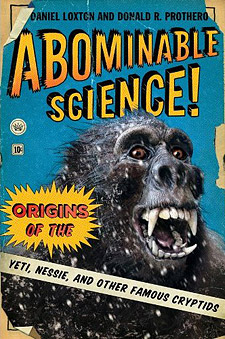Order the hardcover from Shop Skeptic
Order the hardcover from Amazon
Order the Kindle Edition
Order the Apple iBook
When Daniel Loxton and I were doing the research for our book on cryptozoology, Abominable Science, we tracked down monster myths that had been handed down over decades by many different authors. In some cases the back trail for these legends peters out after just a few decades; in other cases, the inspirations for modern cryptid legends may be traced back centuries to the myths of Indigenous Peoples or the artistic expressions of millennia past. No matter the sources, they all ended up in books which indiscriminately compiled every cryptid legend as if they all had robust, plausible histories and back-stories. As we found out, most of the pivotal “sightings” of even the best-attested cryptids were indeterminate or questionable or outright hoaxes, yet they kept on being repeated by the cryptozoology community no matter how doubtful or discredited they were. There was no quality control or careful examination of the reliability of these reports, just stockpiling them all as if they all counted equally. In the end, we recommended that the cryptozoology community needed to get their house in order and weed out the garbage accounts and obvious hoaxes before any scientist would take them seriously.
But the power of the internet has made it possible for myths and legends to spread further and faster than at any time in previous human history. A silly idea like chemtrails (see this post) had no large following until the echo chamber effect of the internet spread it far and wide among conspiracy nuts. Moreover, the internet echo chamber can be manipulated. The literature can be intentionally distorted—especially online, and especially when it is already murky. So it is with cryptozoology, and with the paranormal in general. Hoaxed or worthless Bigfoot videos show up every few weeks on the internet, along with hoaxed videos and photos of many other cryptids, as well as UFOs and aliens and ghosts.
As it turns out, a single individual can exploit the lack of quality control and fact-checking in the cyberworld to create a whole mythology about a cryptid, all by himself. Such has apparently happened with the pterosaur-like cryptid called the “ropen.”
If you look up “ropen” on the internet, you’ll get a bunch of links to various cryptid sites which mention it. Supposedly it is a pterosaur-like creature reported from Papua New Guinea, and it allegedly produces bright lights when it flies. One cryptid site gives the following account:
According to the book Searching for Ropens, it is “any featherless creature that flies in the Southwest Pacific, and has a tail-length more than 25% of its wingspan.” On the Island, the word “ropen” refers to a large nocturnal creature that glows briefly as it flies. The ropen is the subject of folklore (like a man but also like a spirit) but it’s believed by some natives to be a real animal. … The ropen is believed to be nocturnal and to exhibit bioluminescence. Purportedly it lives on a diet of fish, though there have been some reports of the creature feasting on human flesh, especially from grave robbery.
As is often the case with cryptids, the Ropen’s true identity is subject to debate. Some believe it to be a Rhamphorhynchidae-like creature (a pterosaur with a diamond shape tail), while others suggest that the Ropen is a misidentified bat (e.g. flying foxes, which are large fruit bats than can have wingspans up to two metres (six feet), or frigatebirds).
This all sounds impressive until you look a bit further. Brian Switek discussed the fundamental inplausibility of the legend in a column in 2010, but did not spot a deception behind the myth. Virtually all discussion of the ropen comes from a single individual, Jonathan Whitcomb!
Whitcomb admitted the deception in July, 2014 (discussed by other sources since). The book Searching for Ropens? Self-published by Whitcomb. Ropens.com is run by Whitcomb, as is LivePterosaur.com. Modern Pterosaur.com is supposedly written by someone named Norman Hungtingdon. “Who is he? It’s me, Jonathan David Whitcomb,” he admitted. The site Dinosaurs and Pterosaurs Alive.com by Nathaniel Coleman? “That’s also me, and I’m still Jonathan David Whitcomb.” Several sites are maintained by Whitcomb under aliases. In short, it’s a classic case of a typically modern internet phenomenon, sock puppetry, where one individual floods the internet with material using different aliases and email accounts to escape detection (and spam filters). Eventually, it was spread so widely that two paranormal pseudo-documentaries were produced, Destination Truth (on SyFy) and Monster Quest (on the History Channel), all unwittingly based on the obsessions of one individual. Whitcomb admits to his rampant sock puppetry, and doesn’t seem ashamed of the deception:
Why did I use a pen name? It was simple.
If you had Googled something like “live pterosaur” in 2005, the first page may have included a site that included the words “stupid,” “dinosaur,” and “lies” in the URL…but try searching on “live pterosaur” today and you…will find that most of the pages are positive about the possibility of modern living pterosaurs. … I got around potential bias in readers by using that name instead of my own. …I was trying to attract attention to the basic idea of modern pterosaurs, not to my own writing ability. (In fact I altered my writing style for those blog posts using “Huntington.”)
Whitcomb is not the sole creator or enthusiast of the ropen yarn, but his almost single-handed (yet secretly multiplied) role in promoting it is certainly striking. “I seem to have written far more on this subject than anyone else,” he concedes.
What is Whitcomb’s motivation for this one-man crusade to spread the mythical “ropen” all over the internet? It should come as no surprise to those familiar with cryptozoology today that he’s a creationist—in this case, a Mormon creationist who believes there was once a “literal Garden of Eden and that Adam and Eve were indeed real persons and that the Flood of Genesis was what the Bible says it was.” His latest self-published book is entitled Searching for Ropens and Finding God—”a nonfiction book about conservative Christians who search for modern pterosaurs and proclaim that the General Theory of Evolution is patently false,” according to Whitcomb’s description. Like other creationists who focus on claims of extant plesiosaurs or sauropods (Mokele Mbembe), he thinks that the “ropen” somehow invalidates “naturalism philosophy and Darwin’s unlimited common ancestry philosophy…the General Theory of Evolution.”
So beware of citing stuff off the internet. Most of the information from most websites is not fact-checked and is probably garbage, unless you know the site has a good reputation for its reliability. (For its part, Wikipedia deleted its ropen page as one person’s idiosyncratic hype for a “legend” that can only be considered extremely marginal even by cryptozoology standards.)
And never underestimate the power of a single motivated individual to create an entire mythology in cyberspace, all by himself!












Of course there seem to have been countless extinctions of pterosaur species at some time in the past; who denies that? Yet in many sighting reports (from the southwest Pacific, North America, and Africa, etc) certain details dominate: long tails, flange at tail-end, pointed horn-like head crest. Eyewitnesses come from different cultures and have different religions and different levels of education. Some of them have allowed their real names to be published, with no restrictions on future interviews with any scientist or cryptozoologist of any belief or point of view. The details in the descriptions of the flying creatures are exactly what we should expect if one or two basic forms of pterosaur had survived into the present day (regardless of differing beliefs about religion or assumed time frames when pterosaurs dominated the planet in numbers and varieties of species).
And my comments were really tame compared to the dissection that P.Z. Myers did of your work! http://freethoughtblogs.com/pharyngula/?s=ropen
And this review is even more detailed and scathing: http://www.stupiddinosaurlies.org/2014/02/the-pseudo-dragons-of-genesis-park-part_3293.html
A critical point seems to be missing here. Where is the mention of “eyewitness?” I have spent eleven years, and over 10,000 hours, working in this narrow branch (what some might call “twig”) of cryptozoology because eyewitnesses from around the world keep sending me emails about their encounters with flying creatures that seem too unrelated to any bird or bat known to science. And critical points keep coming in, details that suggest honest reporting of strange characteristics: lack of feathers, long tail, flange at the end of tail, cone-like or horn-like appendage coming out the back of the head. Statistical analysis of certain details strongly suggest the lack of any significant hoax involvement. Eyewitness reports make the case. Why ignore that?
As Daniel Loxton and I detailed in our book, “eyewitness testimony” is WORTHLESS in establishing the existence of any cryptid. Decades of psychological research shows that humans are TERRIBLE recorders of what really happened, or what they really saw: they imagine things that didn’t exist, modify their memories after the fact, supply details from cultural cues, etc. And stories from indigenous peoples are not evidence either, since their legends grow the same way with continuous distortion and exaggeration, and their distinction between “myth” and “reality” is often not the same as ours. Videos and photos are just as bad, because they are easily faked, and many show nothing that can be distinguished.
Until you have actual physical evidence (bones or actual specimens), science will not take the “ropen” or any other cryptid seriously.
I never “admitted” any “deception” regarding the names Norman Huntington and Nathaniel Coleman. I also never said that I used “sock puppetry.” Here is part of my reply to those accusations of dishonesty: http://www.modernpterosaur.com/?p=2032 — If I had ever intended any deceit regarding reports of apparent living pterosaurs (many of which reports I deem to have been actual encounters with flying creatures descended from species related to those known from pterosaur fossils), what about my expedition in 2004? Why did I return home to the USA admitting that I never saw anything remotely resembling a pterosaur? If I had ever intended any deception, surely I would have also reported something I had seen, even if only a flying light. I admitted seeing no pterosaur because I was honest.
i have no idea how this video has ANYTHING to do with my post. Were you trying to comment on the “conspiracy theory” posts of a week ago?
Also, “Illuminati” are PLURAL (singular in Latin is “Illuminatus”, but it is a group of people, hence the plural). Throughout your video, all the verbs should match a plural subject, so “Illuminati predict”
I’ve noticed that the e skeptic emails will have a link to an essay or article…But if one clicks on that link, it usually goes to an article or essay *other* than what was listed or described in the e mail. I’m guessing the link is to the current essay, rather than to a specific essay ,and so the link will sooner or later go to the “wrong”one. That’s probably what happened here : Robert followed a link hoping to read about the Illuminati and got an essay on ‘ropen’; I tried to follow a link to read about ropen and got an essay on EUrope.
I just click on the author’s name,and from this list of published articles or essays, I choose the one I was trying to reach.
(BTW, loved Abominable Science! I’ve read it through twice .)
This is not what you may think
“Illuminati Predicts the end of the world”.
It may be disappointing to some who want fantasy and fiction.
http://youtu.be/33-8BCooPi4
I like it! Keep them coming!